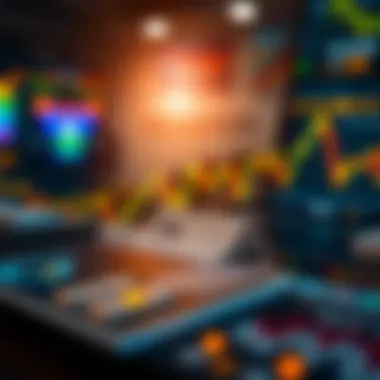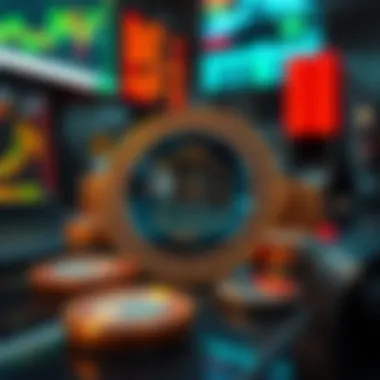Mastering the Futures Market: A Detailed Guide


Intro
The futures market is a complex landscape that offers a world of opportunities for those keen on navigating its intricacies. Unlike traditional trading, where assets are exchanged for immediate delivery, futures contracts bind participants to buy or sell an asset at a specified price on a future date. This unique structure presents both alluring benefits and considerable risks, demanding a thorough understanding for effective engagement.
As we delve into this arena, it’s vital to grasp not just the fundamental mechanics but also the strategies that can be employed to maneuver through market fluctuations. Investors, tech enthusiasts, and academics will benefit from exploring how futures trading interconnects with various financial instruments, influencing broader economic trends and investment strategies.
This guide sets the stage for a multi-faceted examination of the futures market, encompassing market insights, risk management, and analytical frameworks that empower informed decision-making. By dissecting the nuances of trading strategies and the latest developments in this space, readers will find themselves better equipped to navigate the futures market with confidence and clarity.
Prelude to the Futures Market
The futures market is often regarded as a complex realm, populated by a variety of contracts and trading strategies, but understanding its core principles is crucial for anyone looking to navigate the financial landscape. This segment sheds light on the fundamental aspects of the futures market, elucidating its significance and the benefits it offers to traders and investors alike.
At its core, the futures market allows participants to speculate on the future price movements of various assets—be they commodities, currencies, or indices. What sets this market apart is the ability to lock in prices ahead of time, which can be a game changer for both hedgers and speculators. Imagine wanting to shield your business from price fluctuations in wheat or oil; futures contracts provide that shield by allowing you to lock in today's price for future delivery, thus stabilizing your costs.
Furthermore, futures contracts serve as critical tools for price discovery and risk management in financial markets. They facilitate transparent price setting by reflecting collective market forecasts regarding supply and demand dynamics. As such, they play an integral role in enhancing market efficiency, helping establish fair pricing for various assets based on collective insights and expectations.
In addition, this market offers increased liquidity, enabling participants to enter or exit positions swiftly. Investors can utilize futures to broaden their portfolios and leverage their investments through margin trading—a practice where they only need to put down a fraction of the contract value upfront.
Here are a few important considerations when delving into the futures market:
- Volatility: The futures market can be quite volatile; traders should be ready for sudden price swings.
- Research and Education: It's vital to continuously educate oneself about the market's mechanisms, trends, and technical indicators.
- Regulatory Environment: Understanding the regulatory landscape is crucial for compliance and risk management.
"Futures trading is an art and a science; it requires not just a strategy, but also a keen insight into market psychology."
As we venture further into this guide, we will unfold the definition of futures contracts and uncover the pivotal role they play in financial markets.
Key Terminology in the Futures Market
In the realm of futures trading, familiarizing oneself with key terms is akin to learning a new language. Understanding basic terminology tailors your trading approach and enables you to interpret market signals more effectively. Knowledge of these terms is not just educational; it’s fundamentally beneficial to making informed decisions that could affect your investments.
Understanding Pip, Tick, and Point
Pips, ticks, and points are units of measurement that help pinpoint the price movement of futures contracts. Each term has its nuances, and grasping these can bolster your understanding of market dynamics.
- Pip: In many financial markets, a pip signifies the smallest price movement that a given exchange rate can make based on market convention. In the world of futures, it often refers to a change in price and can be significant for traders focusing on currency pairs.
- Tick: While similar to a pip, a tick represents the minimum upward or downward movement in the price of a futures contract. For instance, if a commodity's price moves from $50.05 to $50.06, that movement counts as one tick. Different futures contracts have varying tick sizes, adding more context to trading strategies.
- Point: A point is a broader measure used to indicate a full unit change in price. For example, if a futures contract for crude oil moves from $55.00 to $56.00, that change of $1 is considered one point.
Understanding these measurements is crucial because they can directly influence profit margins and risk assessments. A trader manipulating these units can decide when to enter or exit a position based on price action, and an inadequate understanding might lead to unnecessary risks.
Different Types of Futures Contracts
The futures market encompasses a variety of contracts, each designed to cater to specific needs and objectives. Having a grasp of these contract types is essential for investors, as each comes with distinct features and risks.
- Commodity Futures: These are contracts for physical goods like oil, gold, or wheat. Commodity futures are often used by companies needing to hedge against price fluctuations in the raw materials they rely on. For example, a wheat farmer may sell futures contracts to lock in prices, mitigating the risk of price drops at harvest time.
- Financial Futures: These contracts are based on financial instruments, such as currencies, interest rates, or stock indices. Typically, financial futures are used by institutional investors or large traders who aim to hedge or speculate on market movements. A trader might utilize a futures contract based on the S&P 500 to bet on the overall direction of the market.
- Index Futures: Index futures are a type of financial futures that are linked to stock market indices. This helps investors hedge against future movements in the stock market as a whole. If a trader anticipates declining performance in the market, they could sell index futures to safeguard their portfolio.
- Currency Futures: These contracts are designed for currencies and allow investors to speculate on future exchange rates. A company operating internationally might use currency futures to lock in exchange rates to manage the risk associated with currency fluctuations.
The choice of contract affects investment strategy, risk management, and ultimately, potential returns. By understanding the types of futures contracts available, traders can tailor their approaches to best suit their financial goals.
Knowing the right terminology is like having the right keys to open doors in the futures market. Without them, you risk staying locked out of opportunities that could enhance your trading strategy.
By familiarizing yourself with pips, ticks, points, and the differing types of futures contracts, you set a solid foundation for engaging effectively in the market.
How to Participate in the Futures Market
Participating in the futures market can seem like navigating a maze at first, but getting familiar with the process can set the stage for successful investments. The futures market presents various opportunities for both seasoned and new investors. Understanding the elements involved—such as choosing a broker, setting up an account, and learning how to use trading platforms—is crucial. Each step you take towards participating shapes not only your approach but can also influence your overall success. By arming yourself with this knowledge, you position yourself better within this dynamic environment.
Choosing a Broker
When it comes to participating in the futures market, selecting the right broker is your first significant step. A broker serves as your link to the trading world, facilitating your buy and sell orders. Therefore, it’s important to choose one that fits your specific trading needs. Not all brokers are created equal, and doing some homework can save you grief and costs down the line.
- Regulatory Compliance: Start by verifying that the broker is licensed and follows regulations such as those enforced by the Commodity Futures Trading Commission (CFTC) in the United States. A compliant broker will provide you with some peace of mind.
- Trading Fees: Consider the trading fees and commissions that might eat into your profits. Some brokers charge flat fees, while others might have variable rates. Understanding these charges can help in calculating your margins more effectively.
- Platform Features: Evaluate the trading platform each broker offers. You'll want a user-friendly interface that bogs you down with unnecessary features.
- Customer Support: Look for a broker with responsive customer service. Inevitably, there will come a moment when you need assistance, whether it’s a question about trading strategies, technical difficulties, or withdrawal processes.
It's worthwhile to check online reviews, read through forums like Reddit or specialized financial websites, and gather as much feedback as possible before settling on a broker that feels right.
Setting Up a Trading Account


Once you have chosen a broker, the next step is to set up your trading account. This process can be straight-forward, but it does require due diligence. Each broker may have slightly different protocols, but here are the key steps you generally need to follow:
- Gather Necessary Documentation: Prepare identification documents such as your driver's license or passport. Financial documents might include bank statements or proof of income. Most brokers need to verify your identity to comply with regulations.
- Fill Out an Application: Complete the online application form provided by the broker. This usually involves personal and financial details, including trading experience and objectives.
- Funding the Account: Decide how much capital you want to deposit. Be cautious here; it’s wise not to put more into trading than you can afford to lose. Various funding options may include bank transfers or credit card payments.
- Account Types: Some brokers offer different types of accounts tailored for different trading styles or investment amounts. Make sure you select one that aligns with your individual strategy.
- Verification Process: After submitting your application, the broker will generally take some time to verify your documents. This may take anywhere from a few hours to several days.
Setting up your account correctly can help you avoid many potential hiccups when you start trading seriously.
Learning the Trading Platform
Once your trading account is set up, the next crucial step is to familiarize yourself with the trading platform provided by your broker. Understanding the platform is vital since it’s the tool you will use to execute trades and monitor your investments. Here are some aspects to consider:
- User Interface: Spend time observing where everything is located—the navigation, chart tools, and order-entry section. An intuitive platform can greatly enhance your trading experience.
- Educational Resources: Many platforms offer tutorials, webinars, and demo accounts. Take advantage of these resources to gain firsthand experience without risking your own money.
- Tools and Features: Explore any tools available for technical analysis, market news, or price alerts. Tools can offer valuable insights that aid in making more informed trading decisions.
- Mobile Accessibility: If you prefer trading on the go, check if the platform has a mobile application. Being able to trade from your phone can be a game changer, especially in a fast-paced market like futures.
Taking the time to thoroughly understand your trading platform not only aids in effective trades but also empowers you to leverage various tools for better outcomes.
By carefully choosing your broker, setting up your trading account wisely, and mastering your trading platform, you pave the way for effective participation in the futures market. This knowledge builds your confidence and enhances your trading capabilities.
Market Analysis Techniques for Futures Trading
Navigating the complexities of the futures market hinges on sound market analysis techniques, which are crucial for identifying opportunities and managing risk. Effective analysis allows traders to make informed decisions based on data rather than emotions, dramatically increasing the chances of success. Traders who grasp these techniques can better predict price movements, mitigate unforeseen losses, and capitalize on favorable trends. In essence, mastering market analysis transforms speculation into strategic investing.
Fundamental Analysis in Futures Trading
Fundamental analysis centers on understanding the underlying factors that influence the value of a futures contract. This method digs into economic indicators, supply and demand dynamics, and geopolitical factors, laying the groundwork for a well-rounded perspective on market movements.
To perform fundamental analysis effectively, consider these key aspects:
- Economic indicators: These include Gross Domestic Product (GDP), employment rates, inflation, and consumer spending, which serve as benchmarks for assessing an economy's health.
- Supply and demand: A fundamental tenet of trading, the balance of supply and demand can cause fluctuations in price. For example, a drought affecting wheat crops could drive prices up as supply diminishes.
- News and geopolitical events: Changes in political climates or international relations can significantly impact commodity prices. An escalation in trade disputes may upend market stability, prompting investors to reassess their positions.
Utilizing an economic calendar can also help traders keep track of upcoming announcements and market-moving events. By linking these factors to specific futures contracts, traders can anticipate market shifts and position themselves accordingly. This proactive approach can yield significant advantages when market conditions shift.
Understanding fundamental indicators is like having a map in unknown territory; it guides one's journey, especially during turbulent times.
Technical Analysis Tools and Indicators
While fundamental analysis provides insight into the broader market landscape, technical analysis zooms in on price movements and market sentiment to predict future price action. This method relies on historical data and various indicators to form an opinion on potential trends.
Some of the main tools and indicators to explore include:
- Moving Averages: By analyzing average price data over a particular period, traders can smooth out fluctuations and identify the direction of the trend.
- Relative Strength Index (RSI): This momentum oscillator operates between 0 and 100, helping traders determine whether an asset is overbought or oversold, thus signaling potential reversal points.
- Bollinger Bands: Constructed with a moving average and two standard deviations, this tool identifies volatility and price levels. Prices closing outside the bands can signal potential reversals or trend continuations.
- Fibonacci Retracement Levels: Based on the Fibonacci sequence, these levels help traders identify possible support and resistance points during price corrections.
By combining several technical analysis tools, traders can paint a more comprehensive picture of market behavior. They can spot trends, reversals, and breakouts, which may otherwise go unnoticed. This analytical advantage becomes particularly essential in the fast-paced world of futures trading, where split-second decisions often lead to significant financial outcomes.
As a trader advances, melding fundamental and technical analysis techniques can yield a more robust understanding of the market, allowing for polished and well-informed trading strategies.
Strategies for Trading in the Futures Market
The futures market, with its unique structure and mechanics, necessitates a well-thought-out approach if one hopes to navigate it successfully. Understanding strategies for trading is paramount, as it can make the difference between a well-informed investment and a misstep that drains financial resources. Traders must be aware of various methods based on their objectives, risk tolerance, and market conditions. The upcoming sections will shed light on the following strategies, bolstering your approach:
- Hedging Strategies
- Speculative Market Approach
- Arbitrage Opportunities
Hedging Strategies Explained
Hedging is a risk management technique aimed at reducing potential losses in investments. In the context of futures trading, it involves taking a position in a futures contract that offsets potential price movements in an asset one already holds. For instance, if an investor owns corn stock and fears a price drop, buying a futures contract to sell corn at today's price could prevent losses.
Moreover, hedging isn’t just a safeguard; it can serve as a strategic maneuver to maintain stable profit margins. Businesses often utilize these strategies to stabilize their operating costs, ensuring predictable expenses amid fluctuating markets.
To put it simply, hedging strategies allow investors and companies alike to lock in prices, thereby making them less vulnerable to market shocks. Here are some common types of hedging in the futures market:
- Long Hedge: Buying futures to protect against price increases.
- Short Hedge: Selling futures to guard against falling prices.
- Cross Hedging: Using futures of a related asset to manage risk.
Understanding hedging can enhance your resilience against market volatility.
Speculative Market Approach
On the flip side of hedging, speculation involves taking on risk with the expectation of substantial returns. In this approach, traders exploit price differences to gain profits, often requiring an astute understanding of market trends, news releases, and economic dynamics. The speculative market approach leverages both fundamental and technical analysis. Traders may look at chart patterns, news events, or macroeconomic indicators to make educated guesses on price movements.


This strategy hinges on high rewards with equally high risks. Speculators must be able to ascertain when to enter and exit a trade, using stop-loss orders judiciously to mitigate potential losses. Speculation can be facilitated through:
- Day Trading: Buying and selling positions within the same trading day.
- Swing Trading: Holding positions over several days to capture market swings.
- Position Trading: Maintaining a position over a longer timeframe, based on a movement’s expected value.
While speculation can be lucrative, it’s crucial for investors to recognize the volatility and uncertainties involved. Straying into trading without adequate research can lead to pitfalls.
Arbitrage Opportunities in Futures Trading
Arbitrage refers to the simultaneous buying and selling of an asset to profit from the difference in price across different markets. In the futures market, arbitrage opportunities can emerge when mispricing occurs between the spot market and the futures market or within different futures contracts.
For instance, if the price of crude oil futures is lower than the prevailing market price for immediate delivery, a trader could buy crude oil in the futures market and concurrently sell in the spot market, locking in a profit that capitalizes on the price differential.
Arbitrage can be divided into different techniques:
- Spatial Arbitrage: Involves price differences between geographic markets.
- Temporal Arbitrage: Engaging with price differences over time.
- Statistical Arbitrage: Utilizing mathematical models to find pricing inefficiencies.
Understanding these opportunities requires vigilance and swift execution, as the window for arbitrage can close quickly. Not every trader has the means or resources to exploit these scenarios, but for those who can, it opens doors to considerable profit with limited risk.
In summary, grasping the strategies for trading in the futures market is indispensable for any trader looking to optimize their investment returns. Whether aiming to hedge against losses, speculate on market movements, or exploit arbitrage opportunities, each strategy carries unique advantages and should align with the trader's overall financial goals.
Risk Management in Futures Trading
Engaging in the futures market can feel like walking a tightrope without a safety net. Risk management is not just a buzzword; it’s the lifeblood of effective trading. It helps traders navigate the volatile nature of futures contracts while protecting their capital and ensuring the sustainability of their trading careers. It’s like having a compass in a stormy sea, guiding you through the winds of uncertainty.
When discussing risk management in the context of futures trading, several key elements demand attention. First, understanding leverage and margin requirements is critical. Leverage allows traders to control a large position with a comparatively small amount of capital. However, while it can amplify gains, it can also magnify losses. Calculating the appropriate leverage and knowing the margin requirements are essential steps to safeguard one’s investment. Settle for good sense; remember, high leverage can lead to high risk.
Another cornerstone of risk management is implementing stop-loss orders. This is like wearing a life jacket while sailing; it won't prevent the boat from capsizing, but it gives you a fighting chance. A stop-loss order is simply an instruction to sell a futures contract when it reaches a specific price. This mechanism provides a safety barrier, limiting potential losses and allowing traders to stick to their game plan rather than reacting on impulse during market fluctuations.
"The market is unpredictable, but with sound risk management, you can control your approach."
Establishing and following risk management principles can yield several benefits:
- Preservation of capital: By limiting losses, you ensure that you do not deplete your trading funds.
- Improved decision-making: When you have clear risk management guidelines, you to stick to your strategy and avoid emotional decisions.
- Long-term viability: Sustainable trading practices set you up for potential profits over time, creating an enduring presence in the futures market.
For those interested in this world of futures trading, making risk management a priority is not merely an option; it’s a necessity. Without a comprehensive strategy to manage risk, the chances of navigating the turbulent waters of the futures market diminish significantly. As you delve deeper into trading strategies and patterns, remember that the principle of risk management serves as your foundation, providing a framework to support your trading endeavors.
Assessing Leverage and Margin Requirements
In the futures market, leverage acts as a double-edged sword. It allows traders to control a larger position with a small amount of capital, enticing many with the potential for amplified profits. However, it also opens the door to equally amplified losses.
When you decide to leverage, you’re essentially borrowing money from your broker to trade a larger amount. This can create a scenario where even a small market movement can lead to considerable changes in your equity. Understanding the specifics of margin requirements—the amount of money you need to deposit to open a position—can keep your head above water.
Getting caught in the fire without understanding margin call requirements can be harmful. If your equity falls below a certain threshold, your broker may ask you to deposit more funds or close your positions, possibly locking in losses. Thus, it’s vital to assess your risk tolerance before reaching for high leverage. Consider using a smaller leverage ratio to minimize risk, especially as a beginner or during volatile market periods.
Implementing Stop-Loss Orders
Implementing stop-loss orders in futures trading can serve as your fail-safe. Think of it as setting a speed limit on a winding road; it keeps you within safe boundaries. A stop-loss order instructs your broker to sell a futures contract once it reaches a predetermined price level. This is crucial in managing losses, allowing you to exit a position before it spirals out of control.
There are several styles of stop-loss orders you can use:
- Fixed Stop-Loss: A predetermined price point where you exit, a straightforward approach.
- Trailing Stop-Loss: This adjusts your exit point as the market moves favorably, allowing you to lock in profits while protecting against downturns.
As you progress in your trading journey, recognize the importance of consistency. Sticking to your stop-loss strategy can help you avoid emotional trading, reacting to market volatility rather than letting your predetermined trading plan guide your actions. Implementing stop-loss orders isn't a foolproof shield against losses, but it significantly enhances the robustness of your risk management plan. Make it an integral part of your trading strategy to safeguard your portfolio.
Regulatory Considerations and Compliance
Understanding the regulatory landscape that governs the futures market is akin to navigating a maze; there are various rules and guidelines that shape how trades are conducted. This section explores why compliance is not just a procedural formality but a critical component of successful trading in futures markets.
The futures market, operating on a global scale, is subject to oversight by numerous regulatory bodies. In the United States, the Commodity Futures Trading Commission (CFTC) plays a pivotal role in ensuring fairness, transparency, and efficiency in these exchanges. Regulatory compliance in futures trading helps safeguard market integrity, offering a level playing field for all participants. This oversight is essential for maintaining investor confidence—after all, trust is the lifeblood of any financial market.
Understanding CFTC Regulations
The CFTC has established a framework of rules governing futures trading that focuses on protecting market participants and promoting market integrity. Some core components of these regulations include:
- Transparency Requirements: Futures markets must provide price and volume information to the public, allowing for informed decision-making.
- Reporting Obligations: Participants are often required to report their trading activities, ensuring that regulators can monitor for unusual trading patterns that may indicate malfeasance.
- Clearing Mandate: Futures trades typically need to go through a clearinghouse, which acts as a middleman to reduce counterparty risk. This requirement promotes financial stability by ensuring that obligations can be met even if one party defaults.


By adhering to these regulations, traders not only protect themselves from legal repercussions but also contribute to the overall health of the futures market. Non-compliance can lead to stiff penalties, ranging from hefty fines to trading suspensions, emphasizing the necessity of diligent adherence to these rules.
The Importance of Compliance in Futures Trading
Compliance in futures trading extends beyond just following rules; it encompasses a whole framework designed to mitigate risks and enhance trading outcomes. When traders prioritize compliance, they benefit in several significant ways:
- Risk Mitigation: By complying with regulations, traders reduce the likelihood of encountering costly disputes or regulatory actions that could disrupt their operations.
- Enhanced Credibility: Market participants who uphold compliance standards often enjoy better reputations, making it easier to attract partners and clients.
- Access to Resources: Many exchanges and brokers provide tools, platforms, and resources specifically designed for compliant traders. This access can enhance trading efficiency and effectiveness.
"In the world of futures trading, compliance is more than a checkbox; it's a protective shield that can safeguard one’s investment and facilitate long-term success."
Furthermore, a well-informed trader understands that regulatory changes are part of the landscape. Keeping abreast of ongoing evolutions within CFTC regulations can provide a preparedness advantage. For instance, adjustments made in response to market behavior or technological advancements can directly affect trading practices.
Overall, navigating the regulatory environment may seem daunting, but it's a critical domain that traders must embrace. Knowledge of compliance not only aids in avoiding pitfalls but also contributes to a more vibrant, stable futures market that ultimately benefits all participants.
For more details on regulatory matters pertaining to futures trading, you can visit resources such as the CFTC's official website cftc.gov. Additionally, sites like investopedia.com provide in-depth tutorials on compliance and regulatory practices.
The Interrelationship Between Futures and Spot Markets
Understanding the relationship between futures and spot markets offers vital insights into how financial assets are valued and traded. The futures market operates on the basis of contracts that are settled on a future date, while the spot market involves immediate transactions at the current market price. These two markets are intertwined, influencing each other in significant ways that can affect both prices and trading strategies.
Price Discovery Mechanisms
Price discovery is a crucial element in financial markets, and it refers to the process through which the prices of assets are determined. In simpler terms, it's how buyers and sellers come to agree on the value of something. The interaction between the futures and spot markets greatly facilitates this process.
In essence, when traders in the futures market speculate on future price movements, they contribute to setting expectations that can ripple into the spot market. For instance, if futures contracts are trading significantly above the expected spot price, this could indicate bullish sentiment among investors. Conversely, if futures are trading below the spot price, it may suggest bearish sentiments or an expected downturn in the market.
- Emerging Trends: Futures prices often react to various factors such as economic reports, geopolitical events, and market sentiment, which provides a glimpse into what traders believe will happen in the near future.
- Efficient Markets: Together, these two markets allow for a more efficient price discovery mechanism, as they encompass both immediate needs and future predictions. Thus, better information disperses through the market, allowing participants to make more informed decisions.
Impact of Futures on Spot Prices
The influence of futures on spot prices is profound and multilayered. At its core, futures prices help in shaping expectations of future supply and demand, thereby allowing spot prices to adjust accordingly. Market participants watch the futures market closely to gauge where they believe spot prices are headed.
When there is a strong divergence between futures and spot prices, traders often exploit these discrepancies through strategies such as arbitrage. This activity not only balances the two markets in the short term but also fosters a more stable trading environment.
- Market Forces: If the futures market predicts a higher spot price in the future yet the current spot price does not reflect this, it may lead traders to buy more on the spot market to hedge against potential losses, raising current spot prices as a result.
- Trends and Effects: As various current events unfold, such as reports on crop yields or changes in interest rates, futures markets adjust, leading to immediate effects on spot prices. For instance, if a drought is anticipated, the futures price of agricultural commodities may rise, leading traders in the spot market to increase their purchase prices as well.
"The intricate dance between futures and spot markets reveals not just the price of assets but also the collective expectations and sentiments of market participants."
The interrelationship showcases that neither market operates in a vacuum. Instead, they are interconnected systems that contribute to a more coherent understanding of asset values at any given time.
By recognizing how futures and spot markets interact, investors can sharpen their trading strategies, allowing them to navigate the complexities of financial markets more effectively.
For further reading on related topics, consider visiting Wikipedia on Futures and Spot Markets and Britannica's Overview.
Understanding these foundational elements may provide a competitive edge in today's sophisticated financial ecosystem.
Future Trends in the Futures Market
The futures market is a dynamic component of global finance, continually evolving as new technologies and economic patterns emerge. Understanding future trends in this domain is critical for investors and participants alike. Identifying these trends allows traders to make informed decisions, anticipate market movements, and fine-tune their strategies.
One cannot overlook how the integration of digital advancements is steering the futures market. The capacity to analyze vast sets of data in real time gives traders the upper hand, allowing them to act swiftly and strategically. Also, considering the global economic influences on the futures market is essential, as these factors can shift market dynamics drastically. The interplay between these elements creates a landscape that is both challenging and rich in opportunity.
Emerging Technologies and Their Impact
The role of emerging technologies in the futures market cannot be understated. Blockchain, for instance, offers unprecedented transparency and security within transactions. By minimizing counterparty risk, it enhances trust among participants. Furthermore, algorithms and machine learning tools have become central to execution strategies. These systems can process data at a speed and accuracy level that human traders cannot match.
- Data Analytics: Understanding market sentiment through big data analytics has transformed trading strategies. Utilizing tools that gather insights from social media, news outlets, and financial publications allows traders to gauge market reactions and predict movements effectively.
- AI Trading Bots: Automated trading systems are now commonplace. These bots can execute trades based on set parameters, analyzing market conditions quicker than a human. They can capitalize on fleeting opportunities, ensuring traders never miss a beat.
The adoption of virtual and augmented reality in trading platforms is also a significant trend. These tools can enhance user experience and improve understanding of complex market concepts by providing immersive learning environments for new investors.
Global Economic Influences on Futures
When we talk about global economic influences, it's like pulling on a thread that unravels a larger picture. Economic events across borders can ripple through the futures market. For instance, trade disputes, currency fluctuations, and geopolitical tensions can skew supply and demand dynamics.
- Interest Rates: Changing interest rates in major economies can impact commodity prices. When rates climb, borrowing costs increase, which could lower demand for raw materials, and, as a result, weigh on prices in the futures market.
- Economic Indicators: Reports on employment, GDP, and inflation can influence investor behavior and futures prices. Many traders keep a close eye on these indicators as they often signal where the market may head.
In a nutshell, staying updated on emerging technologies and their applicability, along with understanding global economic influences, equips futures market participants with a toolbox for success.
In the fast-paced environment of futures trading, knowledge and adaptability are key ingredients for navigating future challenges and opportunities effectively.
To delve deeper into these topics, resources such as Investopedia, CFTC, and educational platforms like Coursera can provide substantial insights into trends impacting futures trading.







